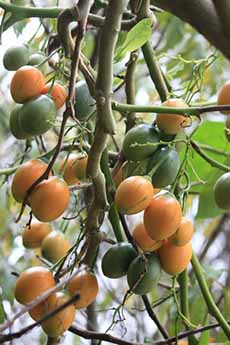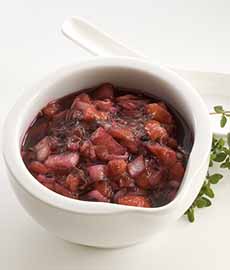What Is A Tamarillo & Tamarillo Recipes
|
In a specialty grocer near you, you may find a colorful stack of New Zealand tamarillos (Cyphomandra betacea)—a relative of tomatoes that looks like a plum tomato, hence its original name, “tree tomato.” Tamarillo, a fruit resembling an oversized plum or a plum tomato, is native to South America, where it has long been used in sweet and savory dishes. While it is an everyday food south of the border, in the U.S., beyond Latino supermarkets, it is sold as an exotic fruits. A member of the Nightshade family (Solanaceae), it’s a relative of the chile, eggplant, potato, and tomato, the tamarillo is native to Central and South America. They can be found in various shades of amber, purple, red, and yellow, all with a green stem. If you live in UDSA Zones 10-11, the winter-hardy trees will be a beautiful addition to your garden, with fragrant blossoms greeting you in springtime before the fruits arrive. > The history of tamarillos is below. They are naturally tangy, but still can be eaten fresh (once the glossy but bitter skin is removed) or cooked. Like grapefruit, fresh tamarillos can be sprinkled with sugar. The apricot-colored, meaty flesh is soft and juicy. Like pears and stone fruits, they yield to slight pressure when ripe. Some call the flavor a cross between a tomato and a tart strawberry. Melissa’s Produce, which sells fruits from all over the world, calls the flavor of tamarillo “habit-forming.” One tamarillo has just 30 calories and is packed with vitamins A (more than 100% DV) and C (50% DV). It is also rich in beta carotene and vitamin E. Choose fragrant, heavy fruits. Once ripened at room temperature, they can be refrigerated for up to 10 days, tightly wrapped in plastic. Tamarillo season runs from now through the fall. If you can’t find tamarillos locally you can purchase them online from specialty produce companies like Melissa’s. Tamarillos can be enjoyed in sweet or savory recipes, Tamarillos can be used in recipes for breakfast, lunch, dinner, and dessert. It can be used in anything from chutneys, salsa, and other condiments to mains, beverages, and desserts: cakes, pies, puddings, and more. It’s easy to peel and slice one into a green salad. We just made one with mixed greens, fennel, sweet onion, basil, and a honey balsamic vinaigrette. Chef Shawn McClain of Chicago’s Spring restaurant serves a salad of tamarillo and fennel dressed with aged balsamic vinegar and Manuka honey. This simple recipe is delicious chicken, fish, or meats. Try on a burger, sandwich, with cold cuts, or a cheese plate; and of course, with tortilla chips. Ingredients 1. PEEL and chop the tamarillos and onion finely. 2. ADD the brown sugar and mix well. 3. REFRIGERATE to let the flavors meld. Recipe by Glenda Gourley for the New Zealand Tamarillo Growers Association. Tamarillos are ancient food. The tree tomato (tomate de arbol) is listed among the “lost crops of the Incas†” because the as tomate de arbol (tree tomato) has all but disappeared from their native Peruvian habitat. They are still grown, commercially, elsewhere in South America. A shrub or semi-woody tree that reaches heights between 10 and 18 feet, tamarillo trees bloom in early spring, producing fragrant pink flowers. Tamarillos spread west from South America to Asia, and then south to Australia and New Zealand. They were first introduced into New Zealand from Asia in the late 1800s. Originally only yellow and purple-fruited strains that originated in South America were produced. The red tamarillo was developed in the 1920s by an Auckland nurseryman, using the seeds from the South American varieties. Other red strains appeared soon afterward and were bred into the large, quality varieties grown in New Zealand today. The commercial production of tamarillos began on a small scale in the 1930s. During World War II, demand for tamarillos grew, when the supply of other fruits high in vitamin C was restricted and sent to the troops. Although tamarillos are from South America, the name is not Spanish, but a New Zealand invention. The fruit was originally known as tree tomato. But to avoid confusion with the garden tomato, and to increase appeal to export customers, in 1967 the New Zealand Tree Tomato Promotions Council decided to rename it. A council member came up with ‘“tamarillo,” feeling that it sounded both Māori (honoring its New Zealand roots) and Spanish (South American roots). In the horticultural boom of the 1970s fruit production increased markedly which led to increasing professionalism among growers with an emphasis on pest control and quality management systems. The fruit is popular in New Zealand thanks to its unique, attractive flavor and nutritional qualities. Tamarillos are grown on a commercial scale in Colombia and Ecuador, with smaller plantings in Africa, Asia, Australia, and California [New Zealand Tamarillo Growers Association]. |
|
|
|
________________ *The Nightshade family, Solanaceae, is a family of flowering plants. Many of their fruits, pods, or roots are edible, while others contain the alkaloid solanine, which is toxic in high concentrations (as in the deadly nightshade, or belladonna, and the tobacco plant). Edible members include the cape gooseberry, capsicum (chile), eggplant, goji berry, potato, tamarillo and tomatillo, and tomato, among others. †Crops cultivated across the Inca Empire included avocado, beans, carob, cashews, chiles, chirimoya, coca, cotton, cucumber, gourd, grains, guayabo, lúcuma, maize, mashwa, oca, peanuts, potatoes, quinoa, squash, sweet potatoes, tomatoes, talwi, and ulluco. Here’s more about Inca farming. Here’s a book, Lost Crops Of The Incas, that you can read free online or download. An excerpt follows: …Pizarro and most of the later Spaniards who conquered Peru repressed the Indians, suppressed their traditions, and destroyed much of the intricate agricultural system. …Crops that had held honored positions in Indian society for thousands of years were deliberately replaced by European species (notably wheat, barley, carrots, and broad beans) that the conquerors demanded be grown. Forced into obscurity were at least a dozen native root crops, three grains, three legumes, and more than a dozen fruits. Domesticated plants such as oca, maca, tarwi, nuñas, and lucuma have remained in the highlands for the almost 500 years or so since Pizarro’s conquest (1533). Lacking a modern constituency, they have received little scientific respect, research, or commercial advancement. Yet they include some widely adaptable, extremely nutritious, and remarkably tasty foods” [from “Lost Crops of the Incas: Little-Known Plants of the Andes with Promise for Worldwide Cultivation,” National Research Council, 1989, Washington, DC: The National Academies Press, Introduction, p. 1].
|
||






